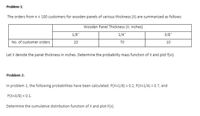
A First Course in Probability (10th Edition)
10th Edition
ISBN: 9780134753119
Author: Sheldon Ross
Publisher: PEARSON
expand_more
expand_more
format_list_bulleted
Concept explainers
Question

Transcribed Image Text:Problem 3:
Suppose that the probability density function of X is
3x
0<x<1
f(x) = {
elsewhere
Determine the P (X<1/3), P (1/3 sX<2/3), and P (X 2 2/3)
Problem 4:
In problem 3, the probability density function of X is
0< x <1
elsewhere
3x²
f(x) = 6
Determine the cumulative distribution function of X.

Transcribed Image Text:Problem 1:
The orders from n = 100 customers for wooden panels of various thickness (X) are summarized as follows:
Wooden Panel Thickness (X; inches)
1/8"
1/4"
3/8"
No. of customer orders
20
70
10
Let X denote the panel thickness in inches. Determine the probability mass function of X and plot f(xi).
Problem 2:
In problem 1, the following probabilities have been calculated: P(X=1/8) = 0.2, P(X=1/4) = 0.7, and
P(X=3/8) = 0.1.
Determine the cumulative distribution function of X and plot F(x).
Expert Solution
This question has been solved!
Explore an expertly crafted, step-by-step solution for a thorough understanding of key concepts.
This is a popular solution
Trending nowThis is a popular solution!
Step by stepSolved in 4 steps with 3 images

Knowledge Booster
Learn more about
Need a deep-dive on the concept behind this application? Look no further. Learn more about this topic, probability and related others by exploring similar questions and additional content below.Similar questions
- Let f(x) = x for 0 < x < 1. Is f(x) a legitimate probability distribution function (pdf) for a continuous random variable? No, the area under f(x) is not 1 (it is greater than 1). Yes, all criteria for a pdf are satisfied. No, the area under f(x) is not 1 (it it less than 1). No, f(x) is not non-negative.arrow_forwardLet X be a continuous random variable with probability density function given by f(x)=x/2 ; Osxs2 and f(x)=0 otherwise. Then the second moment about the zero is 8 4 0.75 2/9 2.arrow_forwardFind the value of k that makes the given function a probability density function on the specified interval. f(x) = kx 2 ≤ x ≤ 6 k= || =arrow_forward
arrow_back_ios
arrow_forward_ios
Recommended textbooks for you
 A First Course in Probability (10th Edition)ProbabilityISBN:9780134753119Author:Sheldon RossPublisher:PEARSON
A First Course in Probability (10th Edition)ProbabilityISBN:9780134753119Author:Sheldon RossPublisher:PEARSON

A First Course in Probability (10th Edition)
Probability
ISBN:9780134753119
Author:Sheldon Ross
Publisher:PEARSON
